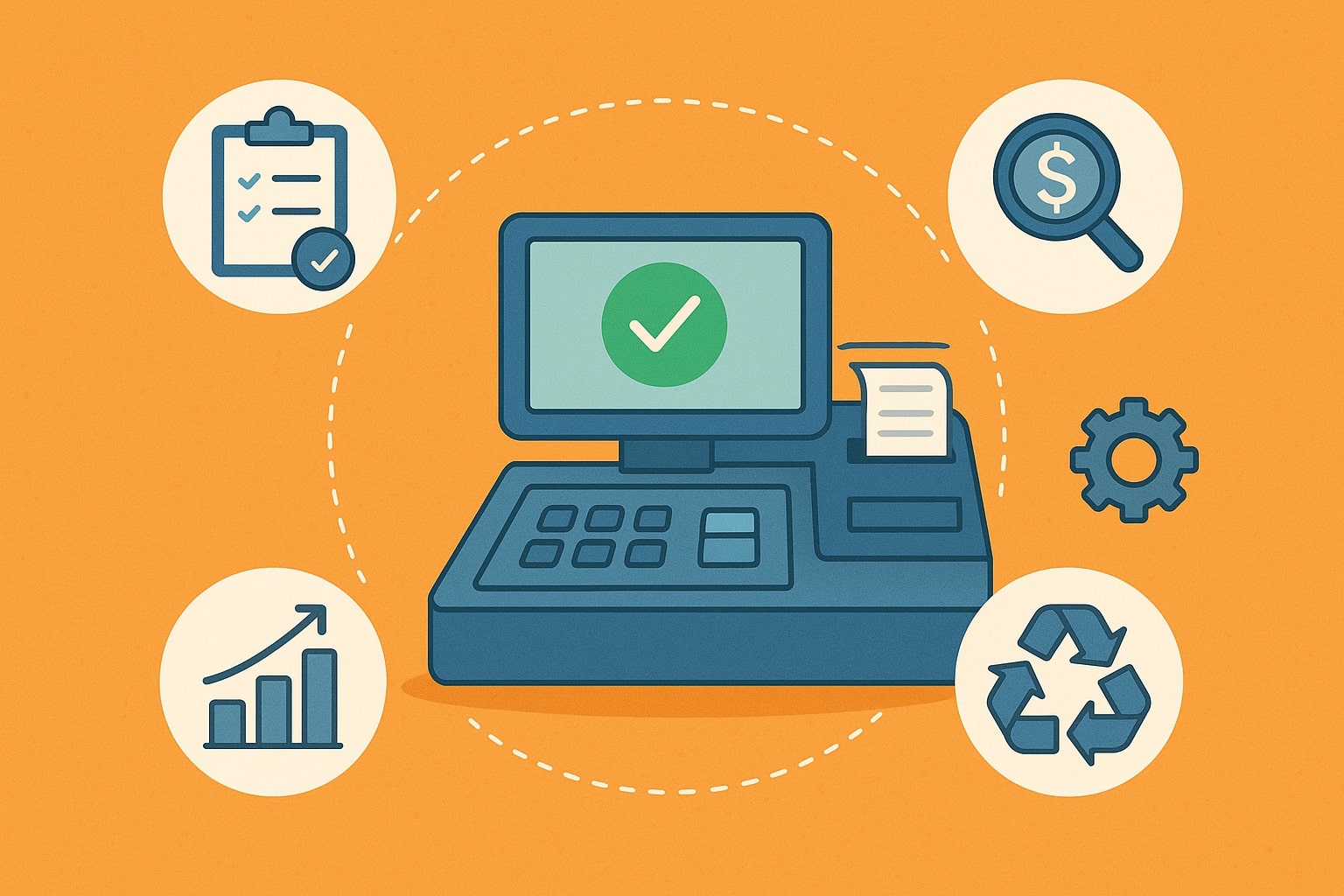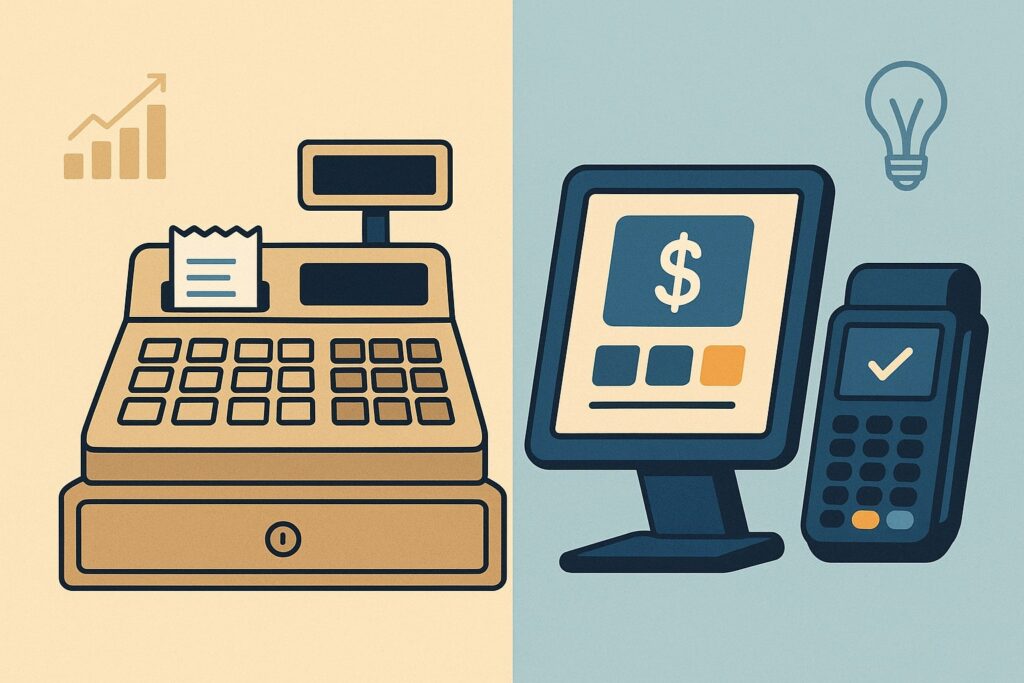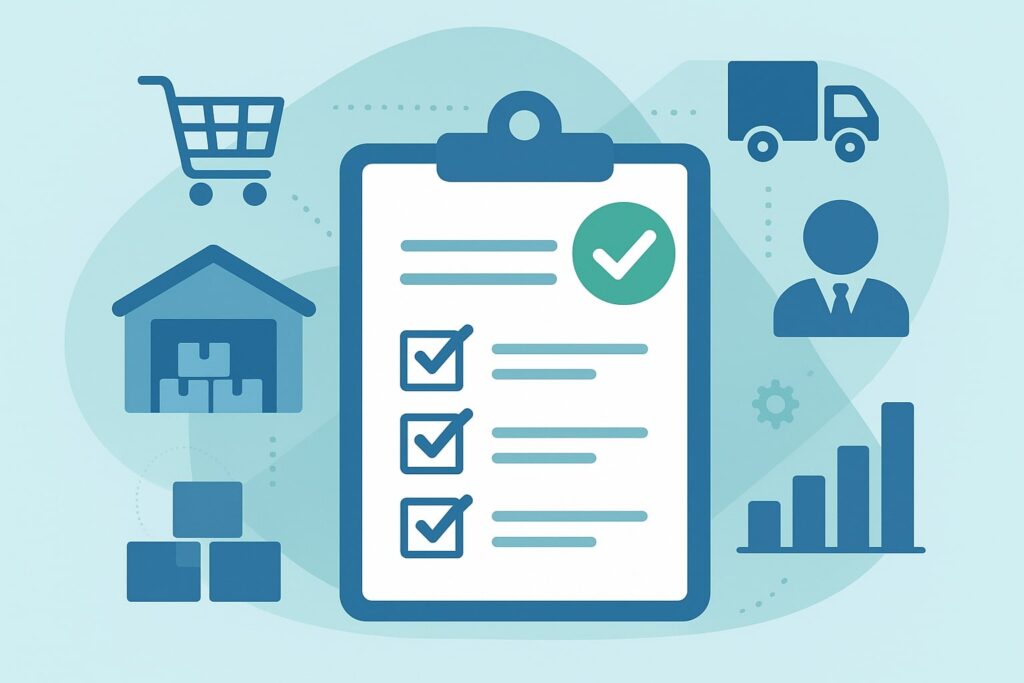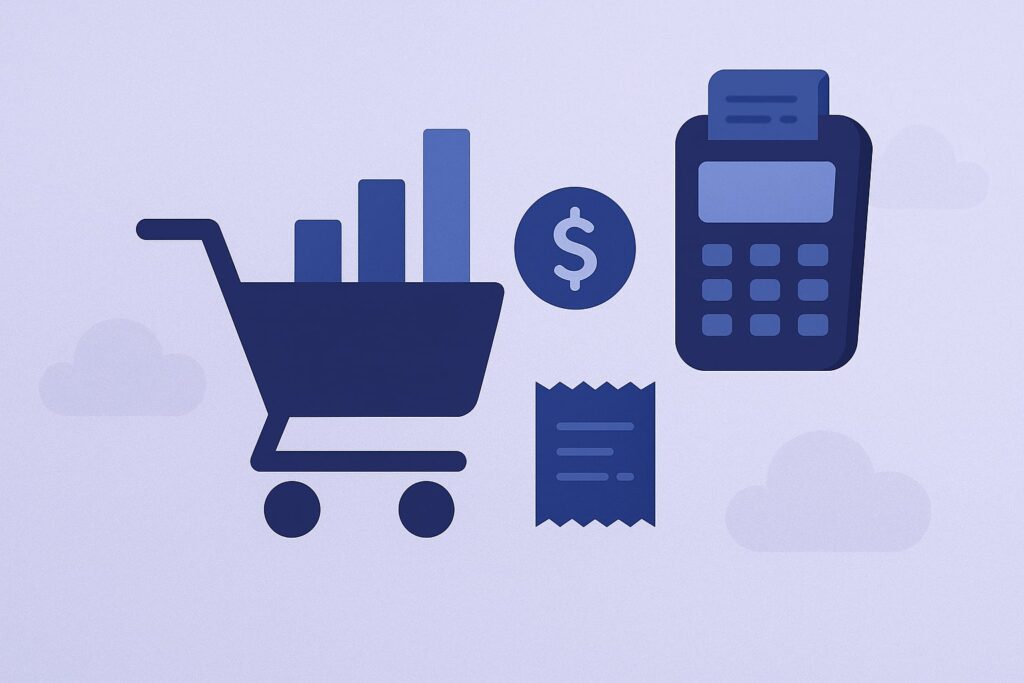
By consignmentpos September 13, 2025
Consignment and resale stores sell unique, one-of-a-kind items on behalf of consignors. Each piece must be tagged, tracked, and linked to its owner until sold. The resale industry is booming – over 25,000 U.S. consignment and thrift shops generate roughly $15 billion a year.
Keeping such diverse inventory organized can be daunting with manual methods. Modern point-of-sale (POS) systems built for consignment automate these tasks, saving hours of work. For example, a specialized consignment POS lets staff scan garments into inventory by vendor, set unique pricing splits, and immediately update stock levels in real time.
By contrast, a generic retail POS often lacks built-in tools for split payouts or vendor accounts, forcing extra work or third-party add-ons. A consignment-focused POS brings everything together – inventory, sales, payments and consignor reports – in one system, so owners spend less time on paperwork and more time growing their business.
Consignment store staff can easily tag and scan items using a POS, reducing manual errors. Modern consignment POS software tracks each vendor’s inventory, automatically adjusting stock as sales happen.
This replaces spreadsheets and tally books with one cloud-based system, eliminating double-entry. The latest systems even sync with online stores, so an item sold on the web instantly reflects in store inventory.
In practice, this means if a denim jacket is sold online, the POS updates in real time and removes it from the store’s available stock. With centralized data, you always know exactly what’s on hand and who to pay for it – a huge improvement over manually checking tags and notes.
Traditional vs. Modern POS Systems

Traditional POS systems run on local hardware and handle only basic sales. They require expensive on-site servers, fixed terminals, and manual updates. By contrast, modern consignment POS solutions are cloud-based.
They use secure online servers, accessible anywhere via tablets or laptops. This shift dramatically cuts setup costs and maintenance: modern systems often use affordable subscription plans instead of big upfront hardware investments.
Mobile devices let staff process sales on the sales floor or at pop-up events, a flexibility old cash registers can’t match. Crucially, modern consignment POS adds industry-specific features missing from general POS.
For example, they automatically calculate consignor commissions, produce detailed vendor payout reports, and include vendor portals for consignors to view their sales – features legacy systems simply don’t offer out of the box.
| Aspect | Traditional POS | Modern/Cloud POS (Consignment-Specific) |
|---|---|---|
| Setup & Cost | On-premise hardware, high upfront costs. | Cloud-hosted, subscription pricing scales with business. |
| Mobility & Accessibility | Fixed terminals, limited mobility. | Mobile/ tablet POS; access anywhere internet is available. |
| Updates & Maintenance | Manual updates on-site; potential downtime. | Automatic cloud updates; minimal disruption. |
| Inventory Management | Basic tracking; data often siloed. | Real-time inventory updates; multi-location sync. |
| Consignor/Vendor Support | Lacks built-in consignor tools; manual payouts. | Automated vendor accounts, splits, self-service portals. |
| Integrations | Standalone; hard to expand. | Integrates with eCommerce, accounting, marketing tools. |
Each row above shows how consignment-focused systems improve on legacy POS. For example, traditional POS may only give basic sales totals, whereas modern systems offer customizable dashboards and reports.
Compared to a fixed register, cloud systems let owners check sales and inventory remotely on their phone or tablet. In short, adopting a modern consignment POS brings together best practices of both worlds: the mobility and data power of cloud computing, plus specialized features built for resale businesses.
1. Streamlined Inventory and Vendor Management

Effective inventory control is the foundation of any consignment business. A robust consignment POS system provides real-time tracking of every item from drop-off to sale. As soon as a clerk scans a jacket or chair into the system, the POS logs details (vendor, price, category) and updates stock counts.
Managers can then search by vendor name, item type, or keyword to find products instantly, avoiding lost or mislabelled merchandise. Cloud-based POS also lets multiple locations share one database: when one store sells an item, all others see it is gone. This centralized control prevents overselling and confusion across outlets.
- Real-Time Inventory Updates: The POS continuously syncs data so that inventory reflects current stock. When an item sells, the system deducts it immediately. Owners no longer have to reconcile paper logs at day’s end – the software does it live.
- Detailed Item Tagging: Modern systems let you tag each piece with images, size, color, and even shelf location. This fine-grained data keeps unique consignments sorted and easy to find. For example, one chain uses barcode scanning and thermal labels to speed up check-in.
- Vendor/Consignor Profiles: The POS manages consignor data automatically. You can set commission splits per vendor and track what each consignor has in stock. The system will even alert you when items reach their consignment period or need markdowns.
- Automated Reordering and Restocking (if applicable): Some consignment stores also buy inventory. A modern POS can generate purchase orders or notifications when stock is low. This automation means your shelves stay filled without manual monitoring.
By automating these inventory tasks, a consignment POS eliminates much of the day-to-day busywork. Staff spend less time on tagging and counting, and errors like duplicate records or missing consignor info are greatly reduced.
In practice, stores report being able to quickly locate items and produce consignor payout statements at month’s end with a single click. Overall, everything from intake to the sales floor is faster and more accurate.
2. Efficient Sales and Payment Processing

At checkout, a consignment POS accelerates transactions and reduces mistakes. Modern systems support multiple payment methods (credit/debit cards, contactless, mobile pay, etc.) through integrated processors.
This means customers can pay with their preferred method in one seamless flow. Unlike outdated registers, a cloud POS also supports mobile checkout: employees can complete sales from a tablet anywhere on the floor, great for busy events or curbside pickup.
- Integrated Payment Processing: The software links directly to card readers and payment gateways. You avoid manual re-entry of amounts – the sale totals flow automatically to the processor. Refunds, returns, and exchanges are all handled within the same system, simplifying accounting.
- Automated Commission Splits: When an item sells, the POS instantly calculates what portion goes to the consignor versus the store. This removes guesswork and ensures accuracy on payouts. No more manually figuring percentages – the system tracks each sale by consignor and computes commissions behind the scenes.
- Special Sales and Promotions: Features like coupons, loyalty discounts, or seasonal mark-downs can be applied at checkout without confusion. The POS also generates and prints barcoded price tags or receipts on demand.
- Layaways and Gift Cards: Many consignment buyers appreciate flexible options. A good POS can hold layaway orders, sell gift cards or store credits, and apply them at checkout. These tools help generate more sales and ensure customers keep coming back.
Overall, checkout becomes a smooth, unified process. Staff ring up items, swipe payments, and finalize sales quickly. The POS immediately updates inventory and consignor balances.
This efficiency shortens lines and gives employees time to focus on customer service. In short, what used to take minutes of math and paperwork can now happen in seconds with virtually no errors.
3. Integrated Multi-Channel Sales and Cloud Access
Today’s shoppers expect to buy anywhere – in-store or online. A consignment POS system bridges these channels seamlessly. E-commerce integration ensures that selling on your website or social media doesn’t require double work.
Many POS solutions automatically sync with online platforms (e.g. Shopify, WooCommerce), updating inventory and sales data in real time. When an item sells online, the store floor instantly knows it’s gone, and vice versa. This unified view prevents stockouts and allows stores to tap into online demand without separate systems.
- Cloud-Based Access: With a cloud POS, you can manage your business from anywhere. Owners and managers can log in from home or their phones to monitor sales, inventory, and consignor activity. All data is encrypted and backed up, so you don’t lose records to hardware failure.
- Mobile/Portable POS: Staff can serve customers with handheld devices. Whether at a mall kiosk or on the sidewalk for a pop-up sale, your team can scan and sell just as well as inside the store. This flexibility is especially valuable during special events or local markets.
- Multi-Location Management: If you operate more than one store or booth, the POS synchronizes across them. You get centralized reports showing combined sales and inventory for all locations. You can transfer stock between stores in the system, and even set different price books for each location if needed.
- Omnichannel Selling: Many consignment POS systems now support in-person, online, and even social media selling from one platform. For instance, you can track sales on Facebook Marketplace or Instagram through integrations. This kind of omnichannel reach opens more revenue streams and keeps inventory consistent.
In summary, consignment POS software connects all the pieces of a modern retail strategy. Whether a customer buys a vintage dress on your website or a retro lamp in-store, the system treats it as one unified sale.
This convergence of channels means better stock control and a wider audience. It also means managers no longer juggle separate systems – everything from front registers to online carts lives in the same dashboard.
4. Enhanced Customer Engagement and Loyalty
Consignment and thrift shoppers often become repeat visitors if treated well. A consignment POS system helps you build those relationships. At checkout, the POS can capture customer information (like email addresses) and purchase history.
This data powers targeted marketing: you might email a customer when new items from a favorite designer arrive, or send coupons for merchandise they often buy. Many systems export customer lists directly into email marketing tools, making promotions easier.
- Customer Profiles: The POS records each customer’s purchases over time. Staff can see past items and preferences when helping a shopper. This personalization makes service faster and more attentive.
- Loyalty Programs: Modern POS often include or integrate with loyalty systems. You can issue points, punch cards, or rewards for repeat buyers. Tracking and redeeming rewards happens automatically at checkout, encouraging customers to return.
- Gift Cards & Promotions: Selling gift cards is a breeze, and you can manage promo codes or special discounts from the same system. Seasonal campaigns or birthday offers can be automated by the POS as well.
- Consignor Communication: Although not customers, consignors also benefit from engagement tools. Some POS platforms automatically email consignors with weekly or monthly statements, showing their items sold and payouts due. This transparency builds trust and often brings consignors back with more items.
By putting customer data to work, consignment businesses see higher retention. For example, stores can turn a one-time visitor into a loyal shopper by sending a timely newsletter or a personal thank-you note generated from the POS data.
Marketing becomes data-driven rather than guesswork. In essence, a consignment POS turns every sale into an opportunity to learn about and engage each customer.
5. Advanced Reporting and Data Insights
Finally, a consignment POS provides powerful reporting tools that drive smarter decisions. Rather than just a daily sales total, modern systems offer customizable dashboards and detailed reports.
Owners can view which products are top-sellers and which sit unsold, down to each consignor’s account. They can analyze sales trends by week, category, or vendor to make informed pricing or ordering choices. These insights replace gut instinct with real data.
- Sales and Inventory Reports: The POS can generate end-of-day and period reports showing total revenue, inventory on hand, and stock age.
You can easily spot slow-moving items and schedule markdowns. For consignment stores, it even shows how much each consignor has sold, so payouts and restocks are timely. - Financial and Accounting Integration: Many systems sync with accounting software like QuickBooks. This means sales data and consignor payouts flow directly into your books, eliminating double entry. Accurate bookkeeping and simpler tax reporting are key behind-the-scenes streamlining benefits.
- Custom Dashboards: Store owners can set up dashboards highlighting the most relevant metrics: current month sales vs. target, profit margins, inventory turns, etc. These at-a-glance views make it easy to monitor performance without manual calculation.
- Automated Alerts: Some POS systems can even alert you when inventory is low or when a consignor’s items haven’t moved. This automation keeps you proactive. For example, the software might notify you that an item reached its consignment limit and needs to be returned, saving time on manual checks.
By centralizing data, the POS turns raw numbers into action. Store managers no longer have to compile spreadsheets or guess at trends. They can pull a report in seconds to see which months are most profitable, how a sale affected revenue, or whether a new vendor is selling well.
In effect, the POS becomes a business intelligence tool: the better you use its reports, the more you can streamline inventory buys, staffing, and marketing for higher efficiency and profit.
Frequently Asked Questions
Q.1: What is a consignment POS system?
Answer: A consignment POS is retail software tailored for resale stores. It combines point-of-sale functions with consignor accounting, inventory tracking, and payment processing.
Unlike a basic cash register, it handles vendor payouts, unique item tracking, and even e-commerce integration. In short, it’s an all-in-one tool built for consignment and thrift shop needs.
Q.2: How does a consignment POS differ from a regular retail POS?
Answer: Consignment POS software includes specialized features that generic systems lack. For example, it automatically splits sales proceeds with consignors and keeps detailed vendor accounts.
It often provides self-service portals and automated consignor statements. A standard retail POS, by comparison, handles basic sales and inventory but would require add-ons for these functions.
Q.3: Can a consignment POS handle online and in-store sales together?
Answer: Yes. Most modern consignment POS solutions synchronize in-store and online channels. Inventory is shared in real time: if an item sells online, the POS immediately updates store stock, and vice versa.
This omnichannel capability means you maintain one consolidated inventory system and can sell the same merchandise on your website, social media, or in-person without overselling.
Q.4: Are consignment POS systems cloud-based and secure?
Answer: Many are cloud-based, offering remote access and automatic updates. Data is stored on secure servers (often encrypted on platforms like AWS), so it’s protected and backed up. Owners can log in from anywhere to check sales or inventory.
This cloud setup avoids reliance on a single terminal – a server crash won’t halt operations or lose all data.
Q.5: How do I choose the right consignment POS for my store?
Answer: Look for a system with strong inventory control, automated consignor accounts, flexible pricing/payout tools, integrated payment processing, and scalable cloud access.
It should offer multi-location support if needed and connect to online sales channels. Free trials or demos help too. The best choice is one that fits your workflow and can grow with your business.
Q.6: Is a consignment POS system expensive?
Answer: Costs vary, but modern systems often use affordable subscription models instead of huge up-front fees. You pay per month or year, which usually includes software updates and support.
This subscription approach means you can start small and add users or features later. While there is a cost, the time saved and sales gained from streamlining operations often make it cost-effective for fast-growing resale businesses.
Conclusion
Modern consignment POS systems revolutionize how resale and thrift shops operate. By integrating inventory control, sales processing, customer management, and analytics into one platform, these systems eliminate much of the manual work that slows traditional stores.
As the resale market grows (with projections reaching $350 billion globally by 2028), using technology is no longer optional—it’s essential. The right POS solution empowers owners to automate everyday tasks, reduce errors, and focus on building relationships with consignors and shoppers.
In practice, stores that adopt these tools report smoother operations, happier staff, and ultimately higher revenue. Whether you run a boutique fashion consignment shop or a large furniture resale business, investing in a consignment-specific POS can streamline your entire operation and pave the way for growth.